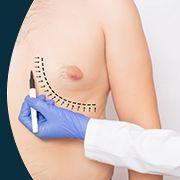Gynecomastia Surgery: What to Expect Before, During, and After
In This Article
Gynecomastia Surgery: What to Expect Before, During, and After
Pooja
Updated on October 04, 2024
Medically verified by Dr. Arya
Fact checked by Dr. Fazeela

Cosmetic
9 min read
It is one that is rampant among many men across the globe since it can cause embarrassment and discomfort.
In some cases, this condition may be arising from other unrelated factors for this reason the condition may improve on its own, however for persistent cases or situations that cause one discomfort surgery is usually encouraged for the correction.
In this blog, Mykare Health will help you with detailed steps on what to expect before, during and after the gynecomastia surgery solutions to enable you to make a sound decision.
Understanding Gynecomastia and Its Causes
Gynecomastia is a result of hormonal disorders mainly affecting the male sex hormone testosterone which is counter checked by oestrogen and later becomes overproduced. Several factors contribute to this hormonal imbalance, including
1. Hormonal Changes: Oestrogen can reach hormonal levels and cause boon for breast tissue during puberty or ageing especially in old people. .
2. Medications: There are situations when a man can develop gynecomastia due to medications some of which include steroids, antiandrogens, drugs used in treatment of conditions such as prostate cancer, heart failure among others.
3. Substance Abuse: The consumption of alcohol, marijuana or any other legal recreational drugs should be avoided to the extent because they are known to cause gynecomastia.
4. Health Conditions: Breast tissue growth can also be the result of hormonal changes which are brought about by kidney ailment, liver ailment, or tumour.
5. Obesity: Obesity also triggers higher production of oestrogen and this will worsen the problem.
When to Consider Gynecomastia Surgery ?
This is the surgical operation whereby the chest area of the male patient is reduced surgically through removal of the fats and the glandular tissue, hence providing the male patient with a more flat picture or rather a more prospective manly contour.
Sometimes drugs and workout can ameliorate the situation but in most serious and recurrent cases of gynecomastia the only treatment is surgery. You may want to consider gynecomastia surgery if
- Your skin becomes sore, painful or inflamed or any other similar uncomfortable feeling one gets when the skin is irritated.
- Concerning the severity factor, the condition impacts your self esteem or body image.
- This condition has not improved – such as gynecomastia which does not improve even with changes in lifestyle or medical therapies.
- You are fit regarding general health and have reasonable expectations concerning the effects of the surgery.
 9 min read
9 min readThe Advantages of Choosing Mykare Health for Gynecomastia Surgery
 6 min read
6 min readIdentifying The Ideal Age For Gynecomastia Surgery
 6 min read
6 min readPre and Post Gynecomastia Surgery: Essential Things to Know
Get a Callback Now
Before Gynecomastia Surgery: Preparation is Key
The next steps that you need to take after consultation with your doctor and determination that you are right for gynecomastia surgery, is preparing for the procedure.
More to do to ensure that the surgery session is as smooth as well as recovery that follows are as good as they should be. Here's what you can expect during this stage:
1. Initial Consultation
The first procedure is very similar to a primary consultation with a board certified surgeon, anaesthetic risk assessment, preoperative, physical examination and diagnostic tests.
During this meeting, the surgeon will
- Tell your doctor about your medical history and any medications that you currently are on.
- Perform a physical examination to evaluate the severity of the condition, preoperatively to confirm you are suitable for the operation.
- Suggest any recommended preoperative tests including the blood test or imaging as a way of excluding any chronic diseases.
- Hear about the operation, its advantages and disadvantages, and what to expect in the following days.
- Explain what you are likely to achieve which should be aligned to the surgical options you have.
2. Preoperative Instructions
The surgeon will give you guidelines with regard to preoperative preparations that are so crucial to follow. These may include
- Medication Adjustments: Certain drugs including the blood thinners and anti inflammation drugs may be prohibited for use before surgery to minimise the side effects.
- Lifestyle Changes: It is best to stop smoking at least two weeks before having surgery since smoking slows the healing process down. In some cases, you also may have to cut down on alcohol intake.
- Fasting: You will probably be advised not to eat or even take beverages and water after midnight the night prior to the operation’s day.
- Arranging Transportation: As it is always recommended that gynecomastia surgery be done under general anaesthetic, you will need a person to drive you back home and perhaps accompany you in the first 24- 48 hours after the surgery.
During Gynecomastia Surgery: What Happens in the Operating Room
Most of the gynecomastia surgeries are done on an outpatient basis which implies that one can be discharged on the same day. It should be noted that the duration of the surgery may vary between 1 and two hours based on the severity of the procedure that is going to be performed.
Here’s a step by step guide to what happens during the surgery
1. Anaesthesia
In case of any surgery you are called upon to undergo, you will be administered with anaesthesia that prevents feelings of pain while the surgery is undergoing. Essentially all gynecomastia surgeries involve the use of general anaesthesia but local anaesthesia with sedation may also be used in some cases.
2. Excision of Tissue
The surgeon will then cut around the areola or under the arm depending on the technique that will be best for his patient. There are two primary techniques used
- Liposuction: If your gynecomastia is due fatty composition the surgeon will resort to liposuction where fat is sucked out from the breast area. A relatively small tube called the cannula is slid through a tiny inconspicuous opening, and the fat is removed.
- Excision: This is especially true if it is necessary to remove glandular breast tissue, or excess skin Depending on the case, the surgeon will perform the excision. This is usually required in other cases where the breast tissue is denser and hence cannot be done through liposuction.
3. Closing the Incisions
After the surgical procedure, there is the surgical removal of heaviness in the bra band as well as skin trimming and the final fusion of incisions with sutures. At times, nasogastric dulls may be placed in order to decrease fluid accumulation; however, these are usually pulled out within forty eight hours of the surgery.
After Gynecomastia Surgery: Recovery and Results
It is part of surgery and knowing what you are going to experience can make you prepare for it appropriately. While recovery times vary depending on the individual, here is a general outline of the postoperative phase
1. Immediately After Surgery
After the operation you will be observed in the recovery room for several hours. After the anaesthesia has worn off, and after testing proves you to be stable you can go home. There is sometimes some chest pain, swelling and bruising but pain and swelling can be managed using drugs given to you by your doctor.
Your surgeon may also give you a garment that is supposed to be worn over the area that you had surgery to compress the area. It is a dressing that assists in minimising inflammation and providing your chest the support that it needs for recovery.
2. The First Few Days
A surgeon advises that for the first few days after surgery a patient should not do much and make sure that he or she does not strain his or her body. Here are a few tips for a smoother recovery
- Pain Management: Administer the prescribed pain relief medicines from your doctor as and when required, in their correct dosage.
- Compression Garment: Wear the compression garment on a full time basis as this helps in reducing the swelling and have a smooth fabricate. This should be worn for a few weeks depending on the achievement sought or as directed by your surgeon.
- Avoid Strenuous Activities: You should not lift anything, engage in any form of physical exercise or exert any of your muscles for at least under one month. Everyday, light walking is recommended in order to help draw blood to the legs and prevent blood clots.
- Followup Appointment: Everything is done within the hospital hence ensure that you complete all the follow up with you surgeon until you are cleared and all the drains or stitches have been removed.
3. Phase One: From Week 1 to 4: Return to Normalcy and Stages of Rehabilitation
This means that after some few days, you will be able to start engaging in your normal activities because the swelling and the pain from the brutality of the shots diminish. However, it is important to
- Avoid Chest Exercises: You will have to stay away from exercises that target your chest muscles including pushups, bench press among others for about four to six weeks at least.
- Monitor Healing: Monitor your incisions to see any signs of infection including redness, or pus like discharge. If you notice that something is wrong then you should report the issue to your surgeon.
4. Long Term Recovery and Results
Most patients can return to work and resume light activities within one to two weeks, depending on the nature of their job. Over the next few months, the swelling will continue to diminish, and the scars will fade. It’s important to protect your scars from sun exposure, as this can cause them to darken.
The results of gynecomastia surgery are typically long lasting, provided you maintain a stable weight and a healthy lifestyle. However, hormonal imbalances or weight gain could potentially cause a recurrence of gynecomastia.
To maintain your results, it's crucial to follow your surgeon’s postoperative care instructions and stay committed to a healthy diet and exercise routine.
Gynecomastia is a condition of men, who developed huge breast size due to hormonal fluctuations, medicines or other lifestyle changes.
Surgery is the best cure to it, more especially when gynecomastia is chronic and when it leads to discomforts and emotional issues.
Preparation includes doctor visits, stopping of specific drugs/medications and patient’s adherence to directives.
The procedure may therefore entail liposuction or tissue excision under general anaesthesia and usually requires one to two weeks of rest for light activities.
Long-term outcomes are mostly permanent, however, the usage of the therapy is obligatory to avoid the recurrence of health issues.



